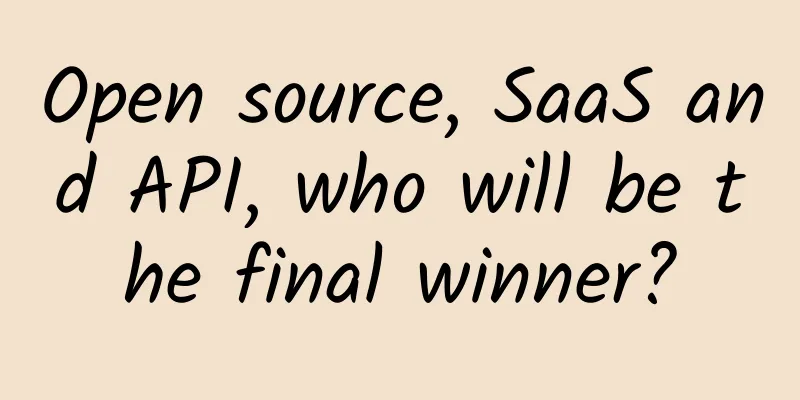Open source, SaaS and API, who will be the final winner?

|
Today, software development has reached a new height, thanks to the reuse of existing innovative modules. Open source, SaaS and API have played a huge role in this process. From now on, developers no longer need to reinvent the wheel every day, but can devote more energy to product innovation. Recently, investor Rodrigo Martinez wrote an article about his views on the development trends of open source, SaaS and API. The above picture is a comparison of the current search trends of the three (from Google). Open source is more of a result of the joint cooperation of independent developers. Its products have unique competitive advantages, such as low risk, low effort, more reliable product quality, stronger industry adaptability, and more transparent products. Open source has become the key to the infrastructure construction of almost every technology company. Therefore, many open source projects have become winners in this market. From the statistical chart below, it is not difficult to find that venture capitalists have invested heavily in open source, and have been expanding in the past two years to explore new business models. But to this day, only a few companies can make money. As a result, compared with other business models, few large businesses are built on open source. SaaS is solving these challenges that open source has encountered. SaaS and open source are mutually exclusive in many scenarios, but they are also related because most infrastructure is becoming SaaS-based. For example, a company's CTO can spend some engineering resources to build a search solution based on Elasticsearch, or accelerate the process by purchasing Algolia's SaaS service. This is the case for contentful, keen.io and other API-first companies. The benefits that SaaS brings to customers are obvious. They have clear usage indicators, clearer product market positioning, predictable revenue, simpler capital planning, and a leaner company staff. These features are undoubtedly more attractive to startups and early investors. The above figure is an analysis of various factors that hinder users from using cloud services to a greater extent. Although it has produced interesting data since 2012, the SaaS field is also full of challenges. SaaS has a strong lock-in effect, and it is difficult to build something on top of a SaaS provider. It is moving in the opposite direction of open innovation; the reliability and privacy issues of cloud services will also become obstacles for customers to migrate data and key infrastructure to SaaS. The emergence of API seems to solve these problems. API, or application programming interface, is a set of predefined functions. In practice, although most APIs are provided in the form of SaaS, the two models are fundamentally different. On the one hand, API is building predefined software modules. Compared with SaaS, API is essentially a platform that allows development on top of it. It has the attribute of "building", which integrates the advantages of open source and avoids the disadvantages of SaaS. On the other hand, API companies focus on solving "small" problems, which is a very professional direction and technically difficult for other companies to crack. Customers are willing to trust API providers to a large extent and use these APIs to build their core infrastructure. Because they believe that "if these people only do these things, they will definitely do it better and more professionally." Obviously, it’s too early to tell whether APIs will beat SaaS or be a natural evolution of it, but Rodrigo is optimistic that the next generation of software “building” will be in the form of APIs. |
<<: iOS Development - Do you really know how to use SDWebImage?
>>: Ten apps that Android developers can't put down
Recommend
Medical industry optimization cases using Sogou, 360, and Shenma
This article shares with you a case study on smal...
Cross-platform and cross-device applications may become a hot topic
The popularity of mobile smart devices also bring...
How to do EDM marketing? Here is a complete guide to promotion
EDM marketing is now used by many product operati...
Deeply understand the principles of Android plug-in technology
[[431328]] Preface The plug-in technology origina...
6 conversion rate analysis models to improve product conversion!
1. Why is conversion rate becoming more and more ...
Does Pinduoduo’s 5.9 yuan saving card save a lot or is it a big scam?
Pinduoduo’s activities always bring surprises. Do...
The underlying idea of planning promotion activities!
In the circle of friends and subscription list of...
How much does it cost to develop an electrician mini program in the Heze market?
How much does it cost to develop an electrician m...
Dudu-2022 Postgraduate Entrance Examination for Master of Translation Systematic Knowledge Lecture
Course Catalog ├──2022 Master of Oriental Transla...
How to build a Baidu promotion SEM bidding account plan? How to create a new plan?
Unknowingly, 2020 has arrived, and many people ar...
How to operate an event well?
This article is divided into three parts: the val...
How much does it cost to be a Yunfu agent for a printing app?
How much does it cost to be an agent of Yunfu Pri...
China Mobile APP Advertising Fraud Analysis Report
PC is disappearing from our daily life scenes at ...
"Understand operations and do marketing" - three steps to operational strategy
In the early days of mobile Internet , the earlie...
With an efficiency of 75%, the photography industry can double the click-through rate of information flow advertising by doing this!
As costume photography is sought after by more an...









